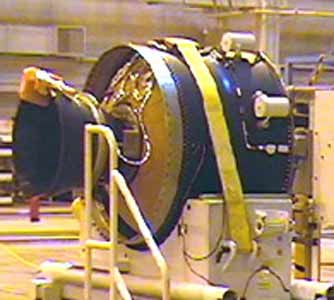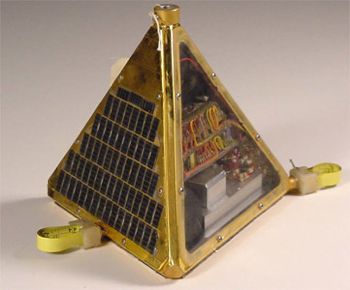
Home - Search - Browse - Alphabetic Index: 0- 1- 2- 3- 4- 5- 6- 7- 8- 9
A- B- C- D- E- F- G- H- I- J- K- L- M- N- O- P- Q- R- S- T- U- V- W- X- Y- Z
ERS

ERS
Credit: NASA
AKA: Earth Resources Satellite. Status: Operational 1962. First Launch: 1962-09-17. Last Launch: 1967-04-28. Number: 7 . Gross mass: 45 kg (99 lb).
Ranging in mass from 0.7 to 45 kg, and carrying from 1 to 14 experiments, these ERS "hitch-hiker" spacecraft provided an inexpensive, flexible vehicle capable of making scientific and engineering measurements in space. A major role of the ERS satellites was to act as a test bed to determine the reliability of improved components and subsystems destined for use in later generations of spacecraft.
A unique feature of the system was its capability to function without a battery. The key to this advantage was the design which permitted solar cells, fastened to all exterior surfaces of the vehicle, to maintain constant exposure of about 15 percent of the sun. The ERS was a small satellite, measuring in one version only 22 cm on a side and weighing 680 g; the larger version weighed 45 kg and was a 51 cm diameter cylinder. At least 12 satellites were launched from 1962 for a variety of missions and sponsors. The 8-sided version was designated the OV-5 and became a part of a program conducted by the Air Force Office of Aerospace Research. Prime Contractor was TRW Systems Group of TRW Inc.
More at: ERS.
Family: Earth, High earth orbit, Magnetosphere sat. Country: USA. Launch Vehicles: Titan, Atlas, Thor, Delta, Titan IIIC, Thor Agena B, Atlas Agena B, Atlas SLV-3 Agena D, Atlas Agena D. Launch Sites: Cape Canaveral, Vandenberg, Cape Canaveral LC13, Vandenberg SLC1W, Vandenberg SLC3W, Vandenberg SLC3E, Cape Canaveral LC41. Agency: USAF, TRW. Bibliography: 2, 278, 279, 405, 6.
 | ORS 3 Credit: Manufacturer Image |
 | ORS 2 Credit: Manufacturer Image |
 | ORS Mk.3 Credit: Manufacturer Image |
 | ORS 1 Credit: Manufacturer Image |
 | TRS 1 Credit: Manufacturer Image |
 | TRS 2 Credit: Manufacturer Image |
 | ORS Mk.2 Credit: Manufacturer Image |
 | TTS Credit: Manufacturer Image |
1962 September 17 - . 23:46 GMT - . Launch Site: Vandenberg. Launch Complex: Vandenberg SLC1W. LV Family: Thor. Launch Vehicle: Thor Agena B.
- TRS - . Payload: ERS 2. Mass: 45 kg (99 lb). Nation: USA. Agency: USAF. Class: Earth. Type: Magnetosphere satellite. Spacecraft: ERS. COSPAR: 1962-A-Chi-xx.
1962 November 11 - . 20:17 GMT - . Launch Site: Vandenberg. Launch Complex: Vandenberg SLC3W. LV Family: Atlas. Launch Vehicle: Atlas Agena B.
- TRS 1 - . Payload: ERS 1. Mass: 45 kg (99 lb). Nation: USA. Agency: USAF AFSC. Class: Earth. Type: Magnetosphere satellite. Spacecraft: ERS. COSPAR: 1962-B-Pi-xx.
1963 July 19 - . 03:51 GMT - . Launch Site: Vandenberg. Launch Complex: Vandenberg SLC3E. LV Family: Atlas. Launch Vehicle: Atlas Agena B.
- TRS 10 - . Payload: ERS 10. Mass: 45 kg (99 lb). Nation: USA. Agency: USAF AFSC. Class: Earth. Type: Magnetosphere satellite. Spacecraft: ERS. COSPAR: 1963-030xx.
1965 July 20 - . 08:27 GMT - . Launch Site: Cape Canaveral. Launch Complex: Cape Canaveral LC13. LV Family: Atlas. Launch Vehicle: Atlas Agena D.
- ORS 3 - . Payload: ERS 17. Mass: 5.00 kg (11.00 lb). Nation: USA. Agency: USAF. Class: Earth. Type: Magnetosphere satellite. Spacecraft: ERS. Decay Date: 1968-07-01 . USAF Sat Cat: 1460 . COSPAR: 1965-058C. Apogee: 111,793 km (69,464 mi). Perigee: 566 km (351 mi). Inclination: 36.90 deg. Period: 2,595.40 min. Radiation data. Space craft engaged in investigation of spaceflight techniques and technology (US Cat A). .
1966 June 9 - . 20:10 GMT - . Launch Site: Vandenberg. Launch Complex: Vandenberg SLC3E. LV Family: Atlas. Launch Vehicle: Atlas SLV-3 Agena D.
- ORS 2 - . Payload: ERS 16. Mass: 15 kg (33 lb). Nation: USA. Agency: USAF. Class: Earth. Type: Magnetosphere satellite. Spacecraft: ERS. Decay Date: 1967-03-12 . USAF Sat Cat: 2202 . COSPAR: 1966-051C. Apogee: 3,641 km (2,262 mi). Perigee: 178 km (110 mi). Inclination: 90.00 deg. Period: 125.10 min. The first Atlas SLV-3/Agena D (7200 Series, Vehicle #7201) standard booster was successfully launched from Vandenberg. Metal-to-metal bonding experiments. Space craft engaged in investigation of spaceflight techniques and technology (US Cat A). .
1966 August 19 - . 19:26 GMT - . Launch Site: Vandenberg. Launch Complex: Vandenberg SLC3E. LV Family: Atlas. Launch Vehicle: Atlas SLV-3 Agena D.
- ORS 1 - . Payload: ERS 15. Mass: 5.00 kg (11.00 lb). Nation: USA. Agency: USAF. Class: Earth. Type: Magnetosphere satellite. Spacecraft: ERS. USAF Sat Cat: 2412 . COSPAR: 1966-077C. Apogee: 3,700 km (2,200 mi). Perigee: 3,680 km (2,280 mi). Inclination: 89.70 deg. Period: 167.60 min. Cold welding experiments. Space craft engaged in investigation of spaceflight techniques and technology (US Cat A). .
1967 April 28 - . 10:01 GMT - . Launch Site: Cape Canaveral. Launch Complex: Cape Canaveral LC41. LV Family: Titan. Launch Vehicle: Titan IIIC.
- ERS 18 - . Mass: 9.00 kg (19.80 lb). Nation: USA. Agency: USAF. Class: Earth. Type: Magnetosphere satellite. Spacecraft: ERS. USAF Sat Cat: 2767 . COSPAR: 1967-040C. Apogee: 110,842 km (68,873 mi). Perigee: 8,991 km (5,586 mi). Inclination: 0.00 deg. Period: 2,831.30 min. Radiation research. Space craft engaged in investigation of spaceflight techniques and technology (US Cat A). .
Back to top of page
Home - Search - Browse - Alphabetic Index: 0- 1- 2- 3- 4- 5- 6- 7- 8- 9
A- B- C- D- E- F- G- H- I- J- K- L- M- N- O- P- Q- R- S- T- U- V- W- X- Y- Z
© 1997-2019 Mark Wade - Contact
© / Conditions for Use